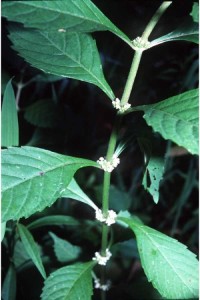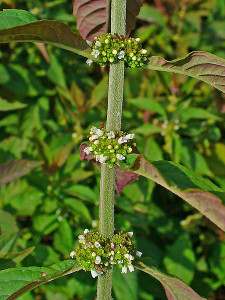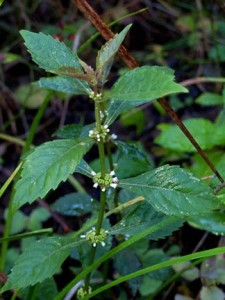Bugleweed (Herb) – Lycopus virginicus
|
Current Demand = GOOD |
Parts Used: Herb |
 |
 |
 |
Family: Labiatae Common Names: Carpenter’s Herb, middle comfrey, sicklewort, Common Bugle…
Description
Bugleweed is a perennial herb that grows up to 3 feet in height. It’s creeping runners produce rosettes of leaves and all together forms a carpet over the ground. The lower leaves are spatula shaped and have a wavy edge while the upper leaves are toothed or oval. Small blue to purple flowers are in abundance from May through July, usually one-half inch across and have dense terminal spikes.
Growing region: Bugleweed is found thru-out the eastern and Midwestern United States, from Nova Scotia to Georgia, west to Oklahoma and north to Minnesota. It is more common in the southeastern areas. It is often found in lower portions of rich moist woods and is in large populations in swampy bog type land.
Planting
Plant bugleweed in part shade and well drained soil. Adding some organic fertilizer will aid the plant in development. Place the plant no more than 4” in the soil and space the plants 9-12 inches apart. Mulch well around the top of the plants (about 3”) and water well. The plants tolerate most soils as long as they are wet and they prefer the full sun or partial shade, damp meadows and by ponds and streams.
Seed – sow spring or autumn in a cold frame. Prick out the seedlings into individual pots when they are large enough to handle and grow them in the greenhouse for their first year. Plant them out into their permanent positions in early summer. Divide the plants in spring or autumn. Larger clumps can be replanted direct into their permanent positions, though it is best to pot up smaller clumps and grow them in a cold frame until they are rooting well. Plant them out in the spring.
Harvesting/Drying
Parts Used: herb
For maximum potency, bugleweed should be harvested in the mid to late summer months while the plant is in bloom. When gathering Bugleweed, only harvest the tops of the plant, not the root. Cut the plant off at ground level to allow the root system to stay in tact for future growth. Gather the larger more mature plants leaving plenty of younger smaller plants to seed the area for future harvest. For drying purposes and to preserve the green color gather the Bugleweed in the afternoon once the morning dew has dried.
After harvest, remove all foreign matter (rocks, weeds and vines) and spread in a thin layer immediately. Bugleweed herb can be dried outdoors though it needs to be dried out of the sun. At night cover the Bugleweed to keep the dew from setting on the drying herb. When possible dry indoors in a well ventilated barn loft or attic to protect against the elements. If natural heat is not available you may need to add heat and a fan for continuous airflow. Whether you dry indoors or outdoors you will need to turn the herb daily.
The key to drying any root, herb or bark in an even combination of heat and airflow. Never use an oven or microwave.
The Bugleweed will be completely dry (largest stem will snap not bend and leaves will crumble) in 3-7 days depending on the drying conditions. Place the herb carefully into a cardboard box, burlap bag or paper bag for storage in a dry area until you are ready to sell or use. Do not store the herb in plastic or it will mold.
Attributes (Image)
Robert H. Mohlenbrock, hosted by the USDA-NRCS PLANTS Database / USDA SCS. 1989. Midwest wetland flora: Field office illustrated guide to plant species. Midwest National Technical Center, Lincoln.
By H. Zell (Own work) [GFDL or CC BY-SA 3.0], via Wikimedia Commons
 Root Buyer
Root Buyer